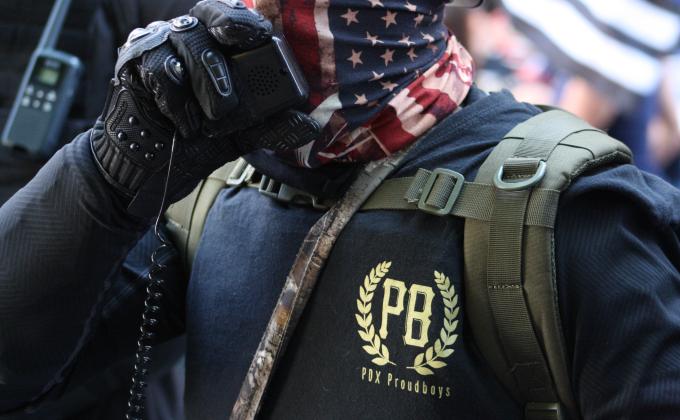On 06 January 2021, hundreds of individuals converged on and broke into the United States (US) Capitol in an attempt to stop the confirmation of the Presidential election. In the immediate aftermath of the Capitol Riot the US Department of Justice (DOJ) has commenced the largest federal investigation in its history. Federal law enforcement’s search for individuals who committed federal offenses during the riot has since amassed more than 200,000 digital media tips, 14,000 hours of body cam videos, and the contents of more than 1,600 electronic devices. More broadly, the events of 06 January radically changed the US government’s focus on counter-terrorism, which during the last two decades was, and continues to be, predominantly focused on international terrorism threats. After these events, the Biden Administration has taken significant steps to shift the focus to the burgeoning domestic terrorism threat. This Perspective reviews the current state of the federal investigation into the perpetrators of the Capitol Riot and provides an overview of the shifting US counter-terrorism landscape. It argues that immediately following the events of 06 January, the US embarked on a dramatic sea change in how it addressed terrorism investigations.
Current state of the federal investigation
As of 01 June 2022, federal prosecutors have charged over 800 people with a range of charges related to their participation in the Riot, from simple trespassing offenses triggered by merely stepping onto restricted Capitol grounds to more serious offenses, ranging from assault of law enforcement to rarely used sedition charges. The investigation is ongoing and new arrests are still occurring, as law enforcement continues to identify protesters based on their social media activity and tips from community members.
While united by a similar desire to prevent Joe Biden’s certification, the Riot participants arrested so far are “by no means a homogenous group”: they hail from over 46 US states, are as young as 18 and as old as 80, and represent a variety of ideologies and organisational affiliations. While a majority of the 835 defendants are male, 115 women have also been arrested.
Additionally, over 100 arrested participants have some degree of military background, while mostly former veterans and not active duty. While at first, this number appears high, it is generally on par with the military affiliation of the general population. However, individuals with a military background present on 06 January were around four times more likely to be members of a domestic extremist organisation, such as the Oath Keepers, when compared to the total number of individuals charged for crimes committed that day. Thirty percent of currently arrested 06 January participants with military experience were also affiliated with domestic violent extremist (DVE) organisations, including some with combat experience.
Two main domestic extremist organisations were present at the Capitol that day: the Proud Boys and the Oath Keepers. Members of each group arrived at the Capitol as a part of organised cells or groups who either planned to disrupt the election certification as an organisation, or as lone actors drawn to the siren call put out by politicians related to the conspiracy theory of ‘Stop the Steal’, which pushed a false narrative that the election was fraudulent. This wrong-headed belief allowed Riot participants to justify in their own minds the heinous attacks on law enforcement and storming of the Capitol. They believed that their country was being stolen by Democrats and, as such, they were participating in a righteous second revolution to save America.
The Proud Boys
Founded in 2016, the Proud Boys have a national leadership cadre with regional chapters that function semi-autonomously and take their own liberties. Members, who are largely young, male and white, share a purported core mission of defending what they see as “Western culture” while adamantly rejecting “foreign” influences, that manifest into white superiority, misogyny, racism, antisemitism, and other hate-filled rhetoric and acts of violence against out-groups.
Notable Proud Boys members, including the group’s former national chairman Enrique Tarrio, currently face federal charges related to the Capitol Riot. While Tarrio was not in Washington (DC) on 06 January, he was arrested two days prior to the Riot for burning a ‘Black Lives Matter’ banner stolen from a DC church and was ordered to stay out of the District. Nonetheless, Tarrio was one of multiple individuals charged for conspiracy due to his alleged involvement in directing the Proud Boys to obstruct the congressional proceeding on 06 January. According to the FBI, Tarrio communicated with several other high-ranking Proud Boys members over an encrypted Telegram chat while they were present at the Capitol. Through this chat, Tarrio allegedly instructed members to follow the command of leadership in DC, including by avoiding their traditional Proud Boys colours or apparel and instead wearing all black attire to blend in. While Tarrio’s case is pending (and whose charges have been since increased to sedition), fifty-one other Proud Boys have been charged, of which a handful have already pleaded guilty, including several leaders of local chapters. For instance, Charles Donohue, the leader of a Proud Boys chapter in North Carolina, pleaded guilty in April 2022 to conspiring to obstruct the congressional proceeding and assaulting law enforcement, and is now obligated to assist investigations in addition to testifying against other charged Proud Boys members.
The Oath Keepers
The other main domestic violent extremist group whose members mobilised on 06 January was the Oath Keepers. Its founder, Stewart Rhodes, created the organisation in 2009 as a bulwark against perceived government tyranny and abuses, and quickly embraced right-wing conspiracies and narratives surrounding election fraud. By the fall of 2020, Rhodes was a true believer of the ‘Stop the Steal’ conspiracy, continually imploring President Trump to invoke the Insurrection Act. Rhodes also called the Oath Keepers to action as a militia against left-wing activists. Similar to Rhodes, a sizeable portion of Oath Keeper members have backgrounds in law enforcement or the military. All told, twenty-nine individuals have been arrested from ten states. Of that, twenty-four were arrested on conspiracy charges, and eight others have pled guilty to a variety of charges ranging from obstruction to violence against law enforcement.
As Rhodes and multiple other Oath Keeper members will face federal trials in September 2022, convictions could set a precedent for future domestic extremism cases. As the US has few legal avenues to charge far-right extremists domestically with terrorism, a sedition precedent could provide the Justice Department with new criminal charging options for the next wave of domestic extremists.
Similarities and differences between both groups
Both the Proud Boys and Oath Keepers are distinctly different right-wing organisations, yet they have rallied behind common interests and goals. Both groups united under the slogan of former President Trump’s campaign to ‘Stop the Steal’ in late December of 2019. Each embraces similar conspiracy theories and acted in a similar fashion during the Capitol Hill Riot. Indeed, 06 January was not the first time Proud Boys and Oath Keeper members protested side by side, as the Oath Keepers have acted as security enforcers during past Proud Boys rallies and other protests, ironically presenting themselves as peacekeepers while often having the opposite effect in reality.
The ways in which both groups have reacted to law enforcement pressure may provide a roadmap for future domestic extremist organisations. The Oath Keepers’ structure was designed around the individual personality of Rhodes, and as such has relied heavily on a top-down leadership model, which can lead to the group fracturing and being relatively aimless without leadership direction. Conversely, national leadership of the Proud Boys provided a degree of hierarchy in major mobilisations such as on 06 January, but in the wake of federal law enforcement’s arrests of major leadership figures, the individual chapters have since largely returned to a state level approach. In the wake of the Riot, this model has afforded the Proud Boys a degree of resiliency that is not necessarily tied to the arrests and convictions of its top management echelons, while the Oath Keepers have struggled with keeping the organisation together.
The Unaffiliated
A majority of the individuals who came to the Capitol were unaffiliated with the Oath Keepers and Proud Boys. Many 06 January participants were inspired by widespread conspiracy theories such as QAnon, which promotes a decidedly false belief system that a large number of US elites are trafficking children, and/or misinformation about the level of fraud in the US electoral system.
There are two ways to look at this phenomenon. One, that 06 January represents a mass radicalisation event of a large subset of the American populace that has concerning and lasting ramifications for domestic extremism in America. In that scenario, a narrowly focused law enforcement effort on only addressing the violent manifestations of extremism will have little to no impact in stemming the rising tide of domestic terrorism. In the alternative scenario, a significant number of the “merely curious” 06 January protestors have expressed remorse with their actions and may be less likely to participate in a similar event in the future. There is some evidence to suggest the latter assessment has weight, as subsequent proposed rallies on the Presidential Inauguration Day and the fall 2021 ‘Justice for January 6th’ DC rally did not produce a large number of participants. Since 06 January, the ‘unaffiliated’ cadre have yet to find a sole flag or cause to rally behind, and the domestic extremism influencer echo chamber appears to be splintering and unable to encourage a large number of its former followers.
Nevertheless, even if organisationally unaffiliated domestic violent extremists are unlikely to group together in a mass event like 06 January in the future, the US Office of the Director of National Intelligence assesses that there remains a significant concern about lone-actor violence as demonstrated by the tragic May 2022 events in a Buffalo supermarket.
The Significant Shift in US Counter-terrorism Approach
Immediately after taking office, the Biden Administration announced what was internally referred to as the “100 day review” of counter domestic terrorism capabilities. Led by the National Security Council, this assessment attempted to radically change the counter-terrorism apparatus. On 15 June 2021, the Biden Administration released the “National Strategy for Countering Terrorism”. Tellingly, this was the first time since 11 September 2001 that an administration produced a dedicated strategy to address domestic terrorism. The strategy has four main pillars: understanding and sharing domestic terrorism information, preventing domestic terrorism recruitment and mobilisation to violence, disrupting and deterring domestic terrorism activity, and confronting long-term contributors to domestic terrorism. An accompanying strategic implementation plan with identified departmental leads for each pillar was also developed but has not been released publicly.
Six months after the strategy was released, the Department of Homeland Security’s (DHS) chief counter-terrorism official lamented that the domestic terrorism threat landscape was more complex and still growing at a rapid pace. When many previous administrations have released policy and strategy documents that sit on a shelf, never to be read again, the Biden administration has made concrete changes at departments and agencies to try to slowly but surely steer the counter-terrorism ship from an international focus to a domestic one. This led to a massive undertaking primarily within the DHS and the DOJ. Shortly afterwards, The White House announced that domestic terrorism was now a DHS “national priority” which, as the name suggests, dramatically changes the ability for the department to award millions of new grant dollars to state and local officials in the fight against this threat. Additionally, DHS reconstituted a domestic terrorism analytic unit, one that had been largely dormant for the last decade.
There was also a change in prosecutorial strategies since 06 January. At the DOJ, prosecutors were reassigned from areas such as white-collar crime to prosecuting domestic terrorism. DOJ national headquarters, or Main Justice, as it is colloquially referred to within the Department, required all of the ninety-four US Attorney Offices to immediately provide an accounting of ongoing domestic terrorism cases. Up until this point, certain cases involving identified domestic violent extremists who were arrested on charges unrelated to extremism or terrorism (for example, firearms violations, drug charges, etc.) were oftentimes siloed within US Attorney’s offices and not counted towards the departmental total of domestic terrorism prosecutions. Without a methodologically complete count, there was often a lack of knowledge within the DOJ about how many ongoing domestic terrorism cases were being investigated and prosecuted, in turn leading to the Department’s inability to properly account and advocate for additional resources from Congress.
The change in the DOJ’s domestic terrorism approach can not only be measured in number, but also in kind. For the last year, the authors interviewed law enforcement officials in multiple field offices about the change in counter-terrorism approaches since 06 January. Interviewees claimed that prior to 06 January, Assistant US Attorneys would often hesitate to take domestic terrorism cases unless there was an overwhelming amount of evidence from undercover employees, confidential sources, or wiretaps. As a result, state-level district attorneys would often bear the brunt of the domestic extremism caseload. That is also beginning to change, as the DOJ now appears to be more willing to handle domestic extremism cases without an abundance of evidence.
These shifts at the federal level on domestic extremism cannot be divorced from the vast amount of time, effort, and resources spent on the Capitol Riot prosecutions. While the DOJ has secured more than 300 convictions to date, largely from pleas, one case has been acquitted by trial when the Judge sided with the defendant’s argument that Capitol Police officers allowed him to enter the compound and thus, was unaware of his charged criminal act. As the discovery for these cases is voluminous, it may trigger some additional acquittals on technicalities given the delay of sharing information with the defence. As the DOJ works towards the Oath Keepers and Proud Boys members’ prosecutions for seditious conspiracy in the upcoming months, a conviction could set legal precedent that may drastically change the course of future prosecutions of domestic violent extremist groups. Indeed, as the US has few legal avenues to charge far-right extremists domestically with terrorism, a sedition precedent could provide the DOJ with new criminal charging options for the next wave of domestic extremists. There is little to no appetite in Congress to expand terrorism charges to fully encompass domestic terrorism. As such, the DOJ will likely be creative in their charging options for domestic terrorism. Nonetheless, while the sedition charges brought against individuals such as Rhodes represent a relatively novel legal approach, these charges are likely to face significant, and possibly successful, legal pushback from their attorneys. As the US Department of Justice works towards the Oath Keepers and Proud Boys members’ prosecutions for seditious conspiracy in the upcoming months, a conviction could set legal precedent that may drastically change the course of future prosecutions of domestic violent extremist groups.
Additionally, the FBI has leaned heavily on previously sparingly used law enforcement techniques such as ‘geo-fencing’, which provided them a list of cell phones that were near the Capitol that day to help them identify new individuals to criminally charge. 06 January has pushed the previous boundaries of domestic extremism investigations and will likely set a precedent for future efforts.
Conclusion
The events that took place on 06 January will continue to be a seminal point in American history. However, the days that followed may ultimately be the more important watershed moments of counter-terrorism posture in the US. While the Capitol Riot represents the largest federal criminal investigation in American history, it will be how the US government radically altered its counter-terrorism approach that will set the new direction for how the US addresses extremism in its midst.
This publication represents the views of the author(s) solely. ICCT is an independent foundation, and takes no institutional positions on matters of policy unless clearly stated otherwise.
Photocredit: Nicole Glass Photography/Shutterstock









